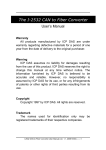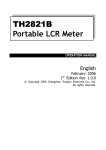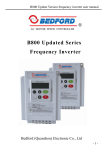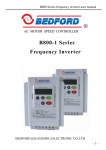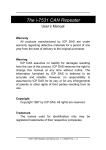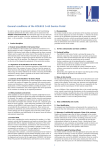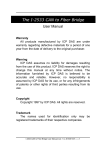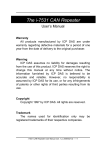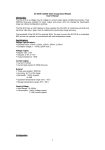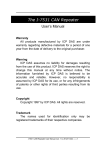Download The I-7532 CAN Bridge
Transcript
The I-7532 CAN Bridge User’s Manual Warranty All products manufactured by ICP DAS are under warranty regarding defective materials for a period of one year from the date of delivery to the original purchaser. Warning ICP DAS assumes no liability for damages resulting from the use of this product. ICP DAS reserves the right to change this manual at any time without notice. The information furnished by ICP DAS is believed to be accurate and reliable. However, no responsibility is assumed by ICP DAS for its use, or for any infringements of patents or other rights of third parties resulting from its use. Copyright Copyright 1997 by ICP DAS. All rights are reserved. Trademark The names used for identification only may be registered trademarks of their respective companies. I-7532 CAN Bridge User Manual (ver. 1.0, 2008/08/25) ------1 Tables of Content Tables of Content...........................................................................................2 1 Introduction.............................................................................................3 1.1 Features..........................................................................................5 1.2 Specifications.................................................................................6 2 3 1.3 Application .....................................................................................6 1.4 Information .....................................................................................6 Technical data .........................................................................................7 2.1 Block Diagram................................................................................7 2.2 2.3 2.4 Appearance ....................................................................................8 LED Status......................................................................................9 Reset & Error Clear Button .........................................................10 2.5 2.6 2.7 2.8 Baudrate Selection Switch..........................................................10 Pin Assignment............................................................................ 11 Wire Connection ..........................................................................13 Terminator Resistor Setting........................................................14 Network deployment ............................................................................15 3.1 Definition ......................................................................................15 3.2 Cable Selection ............................................................................15 3.3 Driving Capability ........................................................................16 3.4 3.5 Baud and Bus Length..................................................................16 Terminator Resistor .....................................................................17 I-7532 CAN Bridge User Manual (ver. 1.0, 2008/08/25) ------2 1 Introduction I-7532 is a local CAN bridge used to establish a connection between two CAN bus system in a CAN network. I-7532 stands by itself connecting adjacent wiring segments together as in the case of a CAN repeater (I-7531). Not just like a CAN repeater, I-7532 has two more powerful features (Extend Network Distance and Connect two networks with different baud rate). Figure 1-1 I-7532 The I-7532 is an optically isolated CAN bridge which provides 2500VRMS optical isolation allowing users to separate and protect critical segments of the CAN network. And it is 3000VDC galvanic isolation isolates both CAN channels from each other as well as from the power supply. The CAN connection of I-7532 is by terminal blocks. A power supply of 10 ~ 30VDC is required. I-7532 is housed in a rugged DIN-Rail mountable box, making it easy to install in an industrial cabinet. I-7532 CAN Bridge User Manual (ver. 1.0, 2008/08/25) ------3 Figure 1-2 Application of I-7532 Extend Distance. The transmission distance limitation of the CAN bus system on each side of I-7532 are independent, which means the total network distance can be extended Figure 1-3 Application of I-7532 Different Baud Connected. The baud rate of two channels on I-7532 can be different for highly flexibility. On the other hand, when the CAN bus system on one side of I-7532 happens some error (e.g. bit error), the system on other side can still work on correctly I-7532 CAN Bridge User Manual (ver. 1.0, 2008/08/25) ------4 Figure 1-4 Application of I-7532 Raise node. I-7532 can enhance the bus load capacity, and users can know how to increase driving capability by table 3-2. 1.1 Features Microprocessor inside with 72MHz. 82C250 CAN transceiver. 2500VRMS photo couple isolation on the CAN side. 3000VDC galvanic isolation among the power supply and 2 CAN channel. 120Ω CAN terminal resistors are integrated (can be disabled by jumper). Watchdog inside. Driving capability: Up to 100 nodes on each CAN channel. Transmission distance up to 1km on each CAN channel. Removable terminal block. Mountable on DIN Rail. 768 frames buffer for each CAN channel. The baud of each channel can be different for highly flexibility. I-7532 CAN Bridge User Manual (ver. 1.0, 2008/08/25) ------5 1.2 Specifications Support CAN 2.0A / CAN 2.0B. Fully compatible with ISO 11898-2. Communication baud : 5K, 10K, 20K, 50K, 80K, 100K, 125K, 200K, 250K, 400K, 500K, 600K, 800K and 1Mbps. Power consumption: 2W max. Power Supply: +10VDC ~ +30VDC. Operating temperature: -25°C ~ +75°C. Humidity: 5% ~ 95%. Dimensions: 122 mm x 72 mm x 35 mm. 1.3 Application Factory Automation. Building Automation. Home Automation. Vehicle Automation. Control system. Monitor system. 1.4 Information For more information about the I-7532, please visit our website: http://www.icpdas.com/products/Remote_IO/can_bus/i-7532.htm I-7532 CAN Bridge User Manual (ver. 1.0, 2008/08/25) ------6 2 Technical data 2.1 Block Diagram The following block diagram illustrates the functions of I-7532 module. Power supply is with 3000VDC galvanic isolated between each CAN port. Furthermore, there is photo-isolation 2500VRMS between two CAN channels. CAN Channel 1 CAN_H DC DC Physical CAN layer 3000VDC Galvanic Isolation 120Ω CAN_L 2500VRMS Photo Isolation CAN Bridge 3000VDC Galvanic isolation 2500VRMS Photo Isolation CAN Channel 2 CAN_H Power Regulator DC DC Physical CAN layer 120Ω Block Diagram of I-7532 +10VDC ~ +30VDC Figure 2-1 Block Diagram of I-7532 I-7532 CAN Bridge User Manual (ver. 1.0, 2008/08/25) ------7 CAN_L 2.2 Appearance CAN Channel 2 CAN_L FG2 CAN_H CAN_GND CAN_L FG1 CAN CH 1 11 CAN_GND 20 CAN_H CAN Channel 1 CAN CH 2 Power & Communication Error LED PWR LED CH1 ERR i-7532 CH1 Rx CH2 ERR CH2 Rx CAN Bus Bridge ‧Support CAN 2.0A/2.0B ‧Selectable 120O terminal resistor ‧Rotary switch value & Baud : RSW 1 2 Baud 5K 10K 20K 9 A B RSW Baud 3 4 5 6 7 8 40K 50K 80K 100K 125K C D E F 200K 250K 400K 500K 600K 800K 1M (B)GND (R)VS+ FG3 RST & Err Clear CH2 Baud CH1 Baud 1 10 3KV VDC Isolation on each CAN side Power Input Baud Switch Reset & Error Clear Button Figure 2-2 Appearance of I-7532 I-7532 CAN Bridge User Manual (ver. 1.0, 2008/08/25) ------8 2.3 LED Status Power LED(PWR LED) Status Table 2-1 Power LED Status PWR LED(Red Light) ON Power On OFF Power off When I-7532 is active, the PWR LED will turn on with red light. Communication LED(CH1RX,CH2RX) Status Table 2-2 Communication LED Status Rx LED(Green Light) Flashing Transmission OFF Bus Idle If there is a message passing through I-7532 from channel 1 to channel 2, the CH1 Rx LED will flash once with green light, and vice versa. Error LED(CH1 ERR, CH2 ERR) Status Table 2-3 Error LED Status ERR LED(Red Light) Flashing (100ms) Transmission Fail Flashing (1sec) Buffer overflow ON Bus Off OFF No Error (1).Transmission Fail: If CAN transmission fails on channel (X), the CH(X) ERR LED will flash continuously and the flashing interval is about 100 ms. (2).Buffer overflow: If Tx buffer on channel (X) has been overflow, the CH(X) ERR LED would flash continuously and the flashing interval is about 1 second. No matter the status is already fixed or not, after user click the “RST” button, the Error LED will be off. (3).Bus Off: If Bus-Off condition happened on channel (X) of I-7532, the CH(X) ERR LED will be always ON until corrected. I-7532 CAN Bridge User Manual (ver. 1.0, 2008/08/25) ------9 2.4 Reset & Error Clear Button Table 2-4 Reset &Error Clear Button Reset & Error Clear Button Click once Clear Error LED Press 3 sec Module Reset (1).Error Clear: Users can click this button to clear the ERR LED status. (2).Module Reset: If users want to reset I-7532, just press “RST & Error Clean” button until 3 sec, then all LEDs on I-7532 will flash once about 0.8 sec. After reset is finished, the PWR Led will be on and other LEDs will be off. 2.5 Baud Selection Switch Users can use the “Baud Rotary Switch” to change the CAN1 and CAN2 baud of I-7532 and it supports 15 kinds of baud on below table. After changing the rotary switch value, users need to reset I-7532 to take the setting effect ( by pressing RST button until 3 sec). Table 2-5 Rotary Switch Value & Baud Switch Value 0 1 2 3 4 5 6 7 Baud [bps] NA. 5k 10k 20k 40k 50k 80k 100k Switch Value 8 9 A B C D E F Baud [bps] 125k 200k 250k 400k 500k 600k 800k 1M I-7532 CAN Bridge User Manual (ver. 1.0, 2008/08/25) ------10 2.6 Pin Assignment 1 20 CAN CH 1 CAN_H FG1 CAN_L CAN_GND CAN CH 2 FG3 (R)VS+ CAN_H FG2 CAN_L (B)GND 10 11 CAN_GND Figure 2-3 CAN & Power Connector of I-7532 Table 2-6 Pin Description of CAN Connector Part CAN CH 1 CAN CH 2 Name Description CAN_GND CAN_Ground, ground voltage level of CAN channel 1. CAN_L CAN_Low, signal line of CAN channel 1. FG1 Frame Ground of CAN channel 1. CAN_H CAN_High, signal line of CAN channel 1. CAN_GND CAN_Ground, ground voltage level of CAN channel 2. CAN_L CAN_Low, signal line of CAN channel 2. FG2 Frame Ground of CAN channel 2. CAN_H CAN_High, signal line of CAN channel 2. Table 2-7 Pin Description of Power Connector Part Power Name Description (R)VS+ Voltage Source. It could be +10VDC ~ +30VDC. (B)GND Power Ground. FG3 Frame Ground of Power. I-7532 CAN Bridge User Manual (ver. 1.0, 2008/08/25) ------11 Note 1: In some cases, the voltage level of CAN_GND of different CAN device in the same CAN bus system are not equal. At this time, it could cause some problems to derogate system stability of this CAN bus system. There is one way to relieve this situation; user can connect the CAN_GND between those CAN devices to achieve equal voltage level of CAN_GND. Wiring of CAN_GND is not necessary; user can modify the configuration of wiring according to actual applications. Note 2: Electronic circuits are constantly vulnerable to Electro-Static Discharge (ESD), which become worse in a continental climate area. FG(Frame Ground) provides a path for bypassing ESD to earth ground, allowing enhanced static protection (ESD) capability and ensures that the module is more reliable. If user wants to use FG, the FG1 and FG2 and FG3 should be connecting to earth ground. Within the I-7532, FG1 and FG2 and FG3 are not interconnected. I-7532 CAN Bridge User Manual (ver. 1.0, 2008/08/25) ------12 2.7 Wire Connection CAN_GND CAN_L Earth Ground CAN_H CAN CH 1 CAN_H Earth Ground CAN_L CAN_GND CAN CH 2 Power Ground +10VDC ~ +30VDC Earth Ground Figure 2-4 Wire Connection of I-7532 I-7532 CAN Bridge User Manual (ver. 1.0, 2008/08/25) ------13 2.8 Terminator Resistor Setting I-7532 includes two build-in 120Ω terminal resistors, users can decide to enable these two terminal resistors or not. The JP4 of I-7532 is used to adjust terminal resistor on CAN Channel 1, and the JP3 of I-7532 is used to adjust terminal resistor on CAN Channel 2. Before adjusting JP3 or JP4 of I-7532, users need to open the cover of I-7532 first. The location of JP3 and JP4 is shown as follows: JP4 JP3 Figure 2-5 JP3 and JP4 positions The following connection statuses present the condition if the terminal resistor is enabled (default) or disabled. Disable (Deactivate) Enable (Activate) Figure 2-6 Adjustment of Terminator Resistor I-7532 CAN Bridge User Manual (ver. 1.0, 2008/08/25) ------14 3 Network deployment 3.1 Definition Following figure is the relation among segments in CAN bus and CAN network. Figure 3-1 Segment, CAN Bus and CAN network 3.2 Cable Selection The CAN bus following ISO 11898-2 is a balanced (differential) 2-wire interface running over either a Shielded Twisted Pair (STP), Un-shielded Twisted Pair (UTP), or Ribbon cable. The table below shows the recommended DC parameters of CAN bus line. Table 3-1 Recommended DC parameters for CAN Bus Line Wire Cross-Section [mm2] Resistance [Ω/km] ~0.25 (AWG23) < 90 ~0.5 (AWG20) < 50 ~0.8 (AWG18) < 33 ~1.3 (AWG16) < 20 The recommended AC parameters of CAN bus line are 120Ω impedance and 5 ns/m specific line delay. I-7532 CAN Bridge User Manual (ver. 1.0, 2008/08/25) ------15 3.3 Driving Capability Users can use the following table to know the maximum node number in each segment and the maximum segment length when using different type of wire in the CAN network Table 3-2 Driving Capability The maximum segment length [m] under the case of specific node number in this segment Wire CrossSection [mm2] 16 Nodes 32 Nodes 64 Nodes 100 Nodes ~0.25 (AWG23) <220 m <200 m <170 m <150 m ~0.5 (AWG20) <390 m <360 m <310 m <270 m ~0.8 (AWG18) <590 m <550 m <470 m <410 m ~1.3 (AWG16) <980 m <900 m <780 m <670 m 3.4 Baud and Bus Length The relationship between ideal bus length and baud in the CAN bus system is displayed below. Table 3-3 Baud, Bus Length Baud [bit/sec] Ideal Bus Length[m] 1M < 40 800K < 50 500K < 100 250K < 250 125K < 500 50K < 1000 20K < 2500 10K < 5000 When users want to calculate the bus length, the device used to connect CAN segment must be considered too. User can check the specification of the device and find the equivalent bus length of the device. For example, the equivalent bus length of CAN repeater (I-7531) is 40m. I-7532 CAN Bridge User Manual (ver. 1.0, 2008/08/25) ------16 3.5 Terminator Resistor According to the ISO 11898-2 specifications, the bus line of CAN_H and CAN_L must be terminated by a terminal resistor for proper operation. The equivalent resistance between CAN_H and CAN_L should be 60Ω. There are some examples below. Case1: RT = 120Ω Case2: RT = 180Ω CAN_H CAN_H RT RT RT RT CAN_L CAN_L RT Case3: RT1 = 180Ω, RT2 = 120Ω CAN_H RT1 RT1 RT2 CAN_L CAN Repeater or CAN Bridge RT1 Figure 3-2 Terminator Resistor I-7532 CAN Bridge User Manual (ver. 1.0, 2008/08/25) ------17 RT2


















